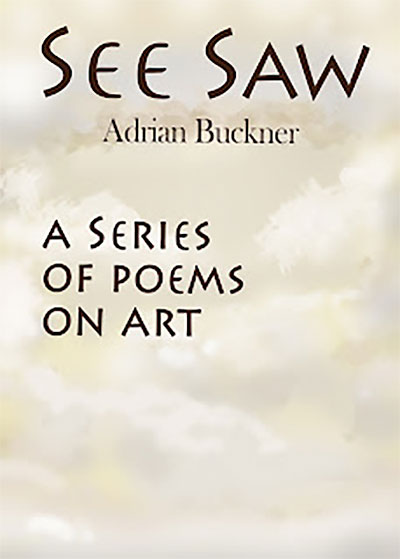
See Saw: a series of poems on art, Adrian Buckner £8.00, Leafe Press)
‘Poems on art’ – i.e. Ekphrasis. Wikipedia tells us that ‘ekphrasis… is a vivid, often dramatic, verbal description of a visual work of art, either real or imagined. Thus, “an ekphrastic poem is a vivid description of a scene or, more commonly, a work of art.”‘ Which, if correct (and I am in no position to argue) the poems in Adrian Buckner’s chapbook are not exactly ekphrastic, because they do not describe, and they are not dramatic – so we can leave that one behind.
But… Wikipedia goes on to say that ‘Ekphrasis has been considered generally to be a rhetorical device in which one medium of art tries to relate to another medium by defining and describing its essence and form, and in doing so, relate more directly to the audience, through its illuminative liveliness.’ I’m not sure I totally understand that – ‘describing its essence’ strikes me as a bit of academic-sounding tosh – but ‘ekphrastic’ perhaps is the word for Buckner’s poems in See Saw after all.
I don’t know, and it doesn’t really matter. I’m not sure why I’m even mentioning it, except that the book’s subtitle might lead one to think that the poems in it are ‘about’ art, and ‘about’ certain paintings. And they aren’t, really. Rather, they are poems in response to paintings, and while the connection between painting and poem is necessarily and understandably close, we are neither talking of descriptions nor, strictly speaking, of interpretations, but of a creative consequence and, for the most part, poems able to stand alone without a painting to help keep them on their feet.
As such, they don’t require of the reader any knowledge of the paintings, although there are maybe a couple of poems where knowing the painting is more than a little bit useful and, anyway, the more you know the better, and looking up the paintings – before, during, or after reading the poem(s) – is an additional bonus pleasure. Indeed, the poems make you want to see the paintings – not so you can ‘get’ the poems, but because the poems strongly, and rightly, suggest that the seeing will be more than worthwhile. And that ‘seeing’ will be wide-ranging, because the paintings referenced span the best part of seven centuries.
The poem from – and I’m going to use ‘from’ rather than ‘about’ or ‘after’ – Fra Angelico’s ‘The Decapitation of St Cosma and St Damian’ is a perfect example of a poem that ‘works’ without the reader needing to know the painting. I quote it here in full:
When I am called to account at The Hague
I will say I was obeying orders
Like the three lads on crowd control rota
Look to the front row for the guilty
The self-absolving gestures
The more in sorrow than in anger
Exporters of rational governance
Through a swing of the sword
A drone strike in the desert
Yes, there is a reference to the painting in the guilty looks of those in the front row, but it’s not a distraction, and the poem brings a chilling 21st century resonance to a 15th century painting. Similarly present-day chilling, and reminding us (if we need reminding) of the eternal darkness of some male intent, is the poem from Artemisia Gentileschi’s ‘Susanna and the Elders’:
Be in no doubt Susanna
We mean to invade
More than your personal space
while Domenico Ghirlandaio’s ‘Old Man and Boy’, a wholly different painting and poem and kettle of fish, finds the poet commenting wryly on audience perceptions and writers’ productions:
Touching
They will call it
And go on to write their novels
Their brief lyrical poems
Buckner has looked at these paintings long and hard. The poem from Perov’s portrait of Dostoevsky captures perfectly the look in the subject’s eyes:
I am not posed in the darkness
I look from the dark
Into a man’s soul
The poems I’ve mentioned so far might be described as fairly concrete in their mode of response to the paintings, but others, such as for example the poem from Karl Schmidt-Rotluff’s ‘Flowering Trees’, which concludes
My heart’s flame
My heart’s ease
reflect with a larger degree of abstraction, while another, the poem from Raoul Dufy ‘s ‘The Avenue du Bois de Boulogne’ is closer to being more explicitly ekphrastic by directly mentioning what’s in the picture. Elsewhere, the artist himself makes an ‘appearance’, when Lowry’s ‘Seascape’ evokes his imagined voice or, if not voice, then thoughts:
Tempted was I
To put a little black dog on the shore?
Perhaps a shivering family
Enduring an awkward exchange?
This round-up of the varied approaches that the poems take explains what, in part, knocks me out about them: the range of response and tone of articulation Buckner achieves, from the chilling to the playful – and how pretty much always it’s a response not of the predictable kind. In that sense they are telling us that our encounters with art neither have to be what the textbooks and guidebooks tell us they should be, nor do they have to be po-faced and completely ‘serious’. They are saying that looking and seeing and using our imagination when engaging with art transcends classroom correctness and whatever someone else might tell us is the way to do it.
But all of that is something of a side issue to the fact that these are pretty much faultless poems that are a delight, an absolute pleasure to read. They may be ‘brief’ and ‘lyrical’, but they are also wonderfully executed and, to mix art-genre metaphors, note perfect. The volume concludes quite beautifully, and tellingly, with Fiona Rae’s ‘I need gentle conversations’:
What the world needs now
Is gentle conversations
It’s the only thing
There’s never been a picture of
© Martin Stannard,2023
